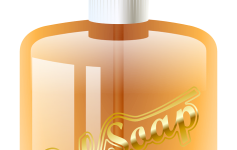We can’t escape the fact that we live in a toxic world.
Furthermore, evidence is mounting that these everyday exposures are adding up
to big-time health implications. So, what should we do? Run to the serene,
unpolluted hills? Well, no. First of all, I don’t think we can find one that is
unpolluted. Secondly, most people are pretty happy with their modern conveniences
and want to be proactive, and not go crazy with fear.
If you want to learn more about the mechanisms behind
how chemicals affect our health, I discussed on my homepage blog the link
between chemicals, health, and autoimmunity.
Here, let’s look at some emerging trends in exposures and
discuss how to avoid them.
How Hand Sanitizers Make
You Absorb More Bisphenol A in Receipts
We’ve all done it. Shopped
all day, gone to grab something to eat, and in between putting the receipt in
our pocket or purse, we grab our hand sanitizer so we can safely munch on our
gluten-free snack. But wait, don’t you dare do that if there’s triclosan in it!
Here’s why, that chemical in your hand
sanitizer will make you absorb a chemical in the receipts that’s hazardous to
your health:
Bisphenol
A (BPA) is an endocrine disrupting environmental contaminant used in a wide
variety of products, and BPA metabolites are found in almost everyone’s urine,
suggesting widespread exposure from multiple sources. Regulatory agencies
estimate that virtually all BPA exposure is from food and beverage packaging.
However, free BPA is applied to the outer layer of thermal receipt paper
present in very high (~20 mg BPA/g paper) quantities as a print developer. Not
taken into account when considering thermal paper as a source of BPA exposure
is that some commonly used hand sanitizers, as well as other skin care
products, contain mixtures of dermal penetration enhancing chemicals that can
increase by up to 100 fold the dermal absorption of lipophilic compounds such
as BPA. We found that when men and women held thermal receipt paper immediately
after using a hand sanitizer with penetration enhancing chemicals, significant
free BPA was transferred to their hands and then to French fries that were
eaten, and the combination of dermal and oral BPA absorption led to a rapid and
dramatic average maximum increase (Cmax) in unconjugated (bioactive) BPA of ~7
ng/mL in serum and ~20 µg total BPA/g creatinine in urine within 90 min. The
default method used by regulatory agencies to test for hazards posed by
chemicals is intra-gastric gavage. For BPA this approach results in less than
1% of the administered dose being bioavailable in blood. It also ignores dermal
absorption as well as sublingual absorption in the mouth that both bypass first-pass
liver metabolism. The elevated levels of BPA that we observed due to holding
thermal paper after using a product containing dermal penetration enhancing
chemicals have been related to an increased risk for a wide range of
developmental abnormalities as well as diseases in adults. (1)
What
to do?
1. Use non-antimicrobial soup and water to wash your
hands.
2. Use a “green” hand sanitizer without triclosan for
your dining pleasure.
3. Avoid triclosan all together, your liver will thank
you! According to a recent study, it was found to cause liver cell
proliferation, fibrogenesis, and oxidative stress in mice. (2-3)
Flame
Retardants Found in Americans for First Time
A
new study has found the carcinogenic flame retardant TCEP in the bodies of
Americans. The study evaluated urinary levels of several phosphate flame retardant
metabolites, like TCEP, which have been largely under the radar. Six
metabolites were found in urine samples from California residents. People with
the highest metabolite levels of two carcinogenic flame retardants also had the
highest levels in their house dust, which were previously tested. (4)
Why
You Should Care?
PFRs
represent a class of poorly studied commercial chemicals with widespread
exposure and raise concerns for health effects including carcinogenicity and
neurotoxicity. (5)
What
You Can Do
Dust
with non-toxic cleaning supplies and avoid purchasing flame retardant products.
Pesticide
& Metal Level in Food
The
Pesticide Issue:
The
U.S. Food and Drug Administration does not perform enough pesticide residue
tests — on either imported or domestic foods – to say whether the
American food supply is safe, according to federal auditors.
The
Government Accountability Office report, which was released Thursday, said FDA
is testing less than one-tenth of 1 percent of all imported fruits and
vegetables and less than 1 percent of domestic fruits and
vegetables. Federal auditors said the agency’s pesticide testing program
is not “statistically valid,” making it impossible for it to meet one of its
mandates, which is to “determine the national incidence and level of pesticide
residues in the foods it regulates.”
The
GAO, an investigative arm of Congress, also raised concerns about both the
FDA’s and the U.S. Department of Agriculture’s decision not to test for many
commonly-used pesticides for which the federal government has set strict
residue limits. Auditors were critical of FDA and the USDA for failing to
disclose this limitation in their annual reports. (6)
The
Arsenic Issue:
New
research has found that more than half of some of the most popular rice cereal
products exceed proposed new limits for arsenic. Although there are strict
limits for the amount of arsenic level allowed in water, there are currently no
maximum levels in food – and now some scientists are speaking out as they are
concerned about the effects of long-term exposure.
Why
Should You Care?
Pesticides and metals have been linked to various health
issues.
Read my homepage blog to find out more and review how
pesticides affect our microbiome here: https://www.saratoga.com/living-well/2014/09/the-strain-of-modern-chemicals-on-our-microbiota.html
What
You Can Do:
Limit pesticides and toxins in your food by eating
organic or cut down on your pesticide exposure by using the Environmental
Working Group’s List of Clean 15 to avoid produce that has with the most
pesticide content.
By knowing what’s out there in our toxic world, we have
the power to keep ourselves healthy.
Sources:
(1) Hormann AM, vom Saal FS, Nagel SC, Stahlhut RW,
Moyer CL, et al. (2014) Holding Thermal Receipt Paper and Eating Food after
Using Hand Sanitizer Results in High Serum Bioactive and Urine Total Levels of
Bisphenol A (BPA). PLoS ONE 9(10): e110509. doi:10.1371/journal.pone.0110509
(2) Mei-Fei Yueh, Koji Taniguchi, Shujuan Chen, Ronald
M. Evans, Bruce D. Hammock, Michael Karin, and Robert H. Tukey. The commonly
used antimicrobial additive triclosan is a liver tumor promoter. PNAS, November
17, 2014 DOI: 10.1073/pnas.1419119111
(3) University of California, San Diego Health
Sciences. The ‘dirty’ side of soap: Triclosan, a common antimicrobial in
personal hygiene products, causes liver fibrosis and cancer in mice.
ScienceDaily. November 17, 2014.
(4) Silent Spring Institute. (2014, November 12). A
previously unrecognized flame retardant found in Americans for the first time.
ScienceDaily. www.sciencedaily.com/releases/2014/11/141112084506.htm
(5) Urinary Biomonitoring of Phosphate Flame
Retardants: Levels in California Adults and Recommendations for Future Studies.
Environmental Science & Technology, 2014; 141112010048007 DOI:
10.1021/es503445c
(6) Kindy, K. Pesticide levels on food unknown due to
poor government testing. November 7, 2014. Washington Post. http://www.washingtonpost.com/blogs/federal-eye/wp/2014/11/07/pesticide-residue-levels-on-food-is-unknown-due-to-poor-government-testing/
(7) Report: Arsenic Found in Common Breakfast Cereals.
Real Farmacy. November 7, 2014. http://www.realfarmacy.com/report-arsenic-found-in-common-breakfast-cereals/#!prettyPhoto



